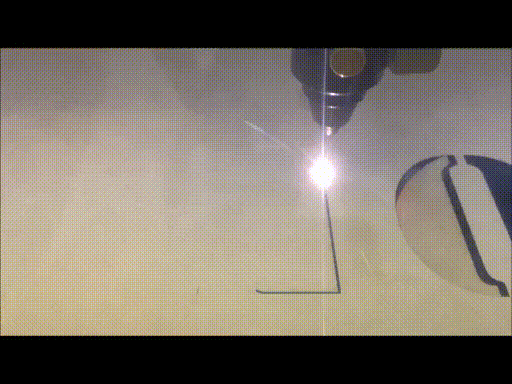Laser cutting is a CNC cutting process in which a high-powered laser is used to cut through materials.
In this process, a high-density light beam is created by stimulating lasing material with an electrical discharge, within an enclosed container. Optics are used to focus the created laser beam onto the workpiece, effectively cutting it by melting, vaporizing, or burning through it. The movement of the laser beam is controlled using CNC technology.

Types of Laser Cutters
There are three main types of lasers used in laser cutters. They are CO2, Nd, and Nd: Yag lasers.
| Laser Type | CO2 (Carbon dioxide) | Nd (neodymium) | Nd: Yag (neodymium-doped yttrium aluminum garnet) |
|---|---|---|---|
| Advantages | • High energy efficiency • High power output ratio | • High energy | • High power output ratio • Can be used to cut thicker material |
| Disadvantages | • Not appropriate for thick metal sheets | • Low repetition efficiency | • Less cost-effective than plasma cutters for such material |
| Applications | This laser is great for boring, engraving, and cutting relatively thin material | This laser is mostly used for engraving and boring | This laser is good for manufacturing and medical industry |
Laser Cutting Materials
Laser cutting can be used to cut a variety of materials such as paper, wood, metal, rock, and many others, but it is widely applied in material removal for sheet metal fabrication of materials such as:
- Aluminum
- Steel
- Stainless steel
- Copper and other metals
In general, laser cutters are great for cutting relatively thin sheet metal with maximum thicknesses of 15 mm for aluminum and 6 mm for steel. They typically have a tolerance of 0.2 to 0.1 mm.
Benefits and Limitations of Laser Cutting
Because of the high precision of laser cutting, minimal finishing is required for laser cut parts. Laser systems create a small heat-affected zone, reducing the need for post-processing heat treatment.
Compared to other cutting processes, laser cutting is more precise and versatile (material wise) than plasma cutting but less than waterjet cutting.
Laser cutting is the most widely used because of its material versatility, precision, and ability to carry out both cutting and engraving (a process that cannot be done with waterjet). It is also cheaper than waterjet cutting.
Cost of Laser Cutting
The cost of Laser Cutting can vary widely depending on the type of laser and on the chosen material. The easiest way to have an idea about the price of your sheet metal fabrication project, is to upload your CAD file to get a free and instant quote.